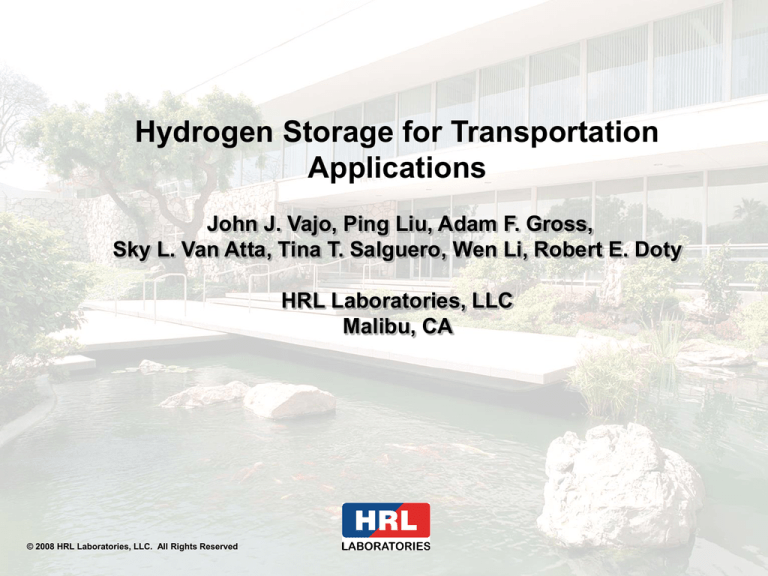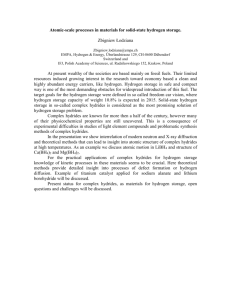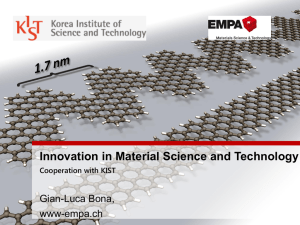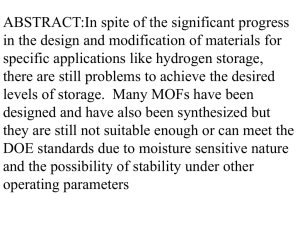
Hydrogen Storage for Transportation
Applications
John J. Vajo, Ping Liu, Adam F. Gross,
Sky L. Van Atta, Tina T. Salguero, Wen Li, Robert E. Doty
HRL Laboratories, LLC
Malibu, CA
© 2008 HRL Laboratories, LLC. All Rights Reserved
Outline
• Introduction to PEM fuel cells and hydrogen storage
needs
• Overview of hydrogen storage approaches
• Solid state methods - advantages and challenges
• Destabilized hydrides (addresses “thermodynamics
challenge”)
• Nanoengineering (addresses “kinetics challenge”)
• Summary
2
Proton Exchange Membrane Fuel Cell
Solid polymer electrolyte sandwiched
between two porous carbon
electrodes containing catalyst
• H2 gas flows to anode– dissociates into
protons and electrons
• Membrane only allows protons to pass
• Electrons follow external circuit to the
cathode (e.g., powers motor)
• Electrons combine with oxygen from air
and protons to form water (exhaust)
Each cell produces < 1 V cells stacked
in series to produce usable amounts of
electrical energy
Hydrogen must be available in
quantities sufficient for fuel cell
operation
Source: U.S. DOE Energy Efficiency and Renewable Energy Office
3
Requirements for Hydrogen
Storage Material System
• High storage capacity
2010 targets:
System weight: >6 % hydrogen; System volume: >45 g/L hydrogen
• Low energy investment to store and remove hydrogen
Temperature for H2 release from storage material must be compatible
with fuel cell operation (~80°C)
• Fast release and refueling times
< 5 min refill time; H2 supply to fuel cell must not be limited by H2 release
rate from hydride
• Material cost consistent with low overall storage system cost
2010 target: $133/kg-H2; 2015 target: $67/kg-H2
• Durability (to maintain 80% capacity):
240,000 km
4
Hydrogen Storage Options
PHYSICAL STORAGE
Molecular
CHEMICAL STORAGE
Dissociated
REVERSIBLE
REVERSIBLE
NON-REVERSIBLE
REFORMED FUEL
LIQUID
HYDROGEN
CRYOADSORPTION
NANO STRUCTURE
ADSORPTION
COMPRESSED
GAS
HYDROLYZED
FUEL
LIGHT ELEMENT
SYSTEMS
DECOMPOSED
FUEL
DESTABILIZED LIGHT
ELEMENT SYSTEMS
CONVENTIONAL
METAL HYDRIDES
COMPLEX METAL
HYDRIDES
• Carbon
• La Ni5
• LiAlH4
• MgH2
• LiH + Si
• Metal Organic
Frameworks
• Ti Fe
• NaAlH4
• Mg Alloys
• MgH2 + Al
• LiBH4
• Mg(BH4)2
• LiBH4 + MgH2
5
Volume of 8 kg Hydrogen in Different Storage Media
(Compared with Gasoline)
Storage Material Volume (Liters)
250
8 kg hydrogen 300 mi range in GM Sequel
200
150
100
50
0
Gasoline
(Assumes ICE 2x less
efficient than fuel cell)
LiBH4
LaNi5H6.5
Liquid-H2
700 bar-H2
6
Volume of 8 kg Hydrogen in Different Storage Media
(Compared with Gasoline)
Storage Material Volume (Liters)
250
8 kg hydrogen 300 mi range in Sequel
200
Total Hydride
Material Weight:
59 kg 570 kg
150
100
50
0
Gasoline
(Assumes ICE 2x less
efficient than fuel cell)
LiBH4
LaNi5H6.5
Liquid-H2
700 bar-H2
7
Solid State Hydrogen Storage Process
Hydrogen
Released
Hydrogen
Material
with
no hydrogen
Material
hydride with
hydrogen stored
Material
with
no hydrogen
Energy to
remove hydrogen
(high heat)
Recycle
To satisfy requirements, materials composed of light metal
elements are needed
8
Light Metal Hydrides are Promising
Candidates for On-Board H-Storage
Potential for high weight (> 6 wt.%) hydrogen storage
Enables 400 km driving range
9
… But Challenges Exist
• Strong covalent/ionic chemical bonds in hydride
High temperatures (>200°C) needed for hydrogen release
thermodynamics challenge
• Bonding is highly directional
Large barriers for atomic diffusion
Leads to prohibitively slow reaction rates (slow hydrogen
uptake and release)
kinetics challenge
These are the principal issues being addressed in
the HRL hydrogen storage program
10
Comparison Of Selected Hydrides with
DOE System Requirements
H2 Capacity (wt.% - material basis)
14
12
LiH
LiBH4
DOE 2010
System
Target
10
Conventional
(transition-metal)
hydrides
30% system penalty
8
Light-metal
hydrides
MgH2
0% system penalty
6
4
NaAlH4
Mg2NiH4
VH2
2
ZrMn2H3.6
ZrNiH3
0
500 400
300
200
100
LaNi5H6.5
20
Temperature (°C)
• Existing hydrides do not meet DOE requirements
• Need either new material or method for altering existing hydrides
11
Strong Bonds in Light Metal Hydrides
– Bond breaking (H2 release) requires high temperature –
Metal (M)
Dehydrogenated State
ENERGY (Heat)
M + H2
M
M
M
M
M
M
M
M
M
High energy
path
MH
Hydrogenated State
Hydrogen Gas
+
H
H
High
Temperature
H
M
H
M
H
M
H
M
H
Metal Hydride (MH)
Conventional hydrides
12
Hydride “Destabilization” by Alloy Formation
Reduces Temperature for H2 Release
Dehydrogenated State
Alloy
ENERGY
M + H2
MAx+ H2
Alloy State
Lower energy
path
A
M
A
M
A
M
A
M
A
Hydrogenated State
+
H
H
Reduced
Temperature
H
M
MH + xA
Hydrogen Gas
H
M
H
M
H
M
+
A
A
A
A
H
Destabilizing
Metal Hydride
Agent
Destabilized hydrides
• Alloy gives tightly bound metal hydride a lower energy path to release H2
• Reduced energy demand means lower temperature for hydrogen release
13
LiBH4/MgH2 Destabilized System
– a promising candidate –
2LiBH4 + MgH2 2LiH + MgB2 + 4H2
Lithium
Magnesium
borohydride
hydride
Lithium
hydride
Magnesium Hydrogen
boride
(System with very high storage capacity (11.4 wt.%, 95 g/L)
LiH + B + H2
ENERGY
T=400°C
LiH + MgB2 + H2
• System has been tested: 10 wt.%
capacity demonstrated
• Temperature for H2 release lowered
175°C by alloying with MgH2
T=225°C
LiBH4 + MgH2
Ref: J. J. Vajo, S. L. Skeith, F. Mertens “Reversible Storage of Hydrogen in Destabilized LiBH 4”, J. Phys. Chem. B, vol. 109
(2005) pp. 3719-3722.
14
Destabilization of LiBH4 by Alloying with
MgH2 Reduces Temperature
H2 Capacity (wt.% - material basis)
14
12
LiH
LiBH4
DOE 2010
System
Target
LiBH4/MgH2
10
Conventional
(transitionmetal) hydrides
30% system penalty
8
Light-metal
hydrides
MgH2
0% system penalty
6
4
NaAlH4
Mg2NiH4
Destabilized
light-metal
hydride
VH2
2
ZrMn2H3.6
ZrNiH3
0
500 400
300
200
100
LaNi5H6.5
20
Temperature (°C)
Significant reduction in H2 release temperature with only
small decrease in capacity (13.6 wt.%11.4 wt.%)
15
Summary of Destabilized Systems and
Comparison with Known Hydrides
H2 Capacity (wt.% - material basis)
14
12
LiH
LiBH
DOE 2010
System
Target
4
10
8
30% system penalty
MgH2
0% system penalty
6
Conventional
(transitionmetal) hydrides
Light-metal
hydrides
Destabilized
light-metal
hydrides
NaAlH4
4
Calculated
Mg2NiH4
VH2
2
Demonstrated
ZrMn2H3.6
ZrNiH3
0
500 400
300
200
100
LaNi5H6.5
20
Temperature (°C)
• Hydride destabilization is a versatile approach for reducing temperature
• However; reaction rates are much too slow for practical use
16
Enhanced Reaction Rates Using
Nano-engineering
Increase Hydrogen exchange rate by decreasing particle size
Bulk Alloy Material
Nanoparticles
<100 nm
Long diffusion distances in
bulk material:
slow H-exchange rate
Short diffusion distances in
nanoparticles:
fast hydrogen exchange rate
Need efficient, low cost method for producing nanoparticles
Issues:
Sintering during hydrogen uptake and release can increase
particle size – could be a big problem
17
Carbon Aerogel “Scaffold” Hosts for
Nanoscale Hydrides
Carbon Aerogels
• Inter-penetrating network of carbon
nanopores (10-30 nm pore size)
• “Scaffold” serves as structure-directing
agent for forming nano-scale hydrides
Incorporate molten LiBH4 into aerogel by “wicking” process
C-aerogel
cubes
Mix aerogel and
LiBH4 under N2
Melt LiBH4
(T=290 °C)
Aerogel
absorbs LiBH4
Scrape to remove
surface material
18
Faster Hydrogen Release from LiBH4 in
Nanoporous Carbon Scaffold
LiBH4 LiH + B + 1.5H2(13.6 wt %)
Pore size distributions
8
0.10
25 nm
13 nm
25 nm
3
6
Pore Volume (cm /g-nm)
Desorbed H2 (wt % LiBH4)
300 °C
4
2
Graphite
0
0.0
0.08
13 nm
0.06
0.04
0.02
0.00
0.2
0.4
0.6
Time (hr)
0.8
1.0
0
5
10
15
20
25
30
35
Pore Size (nm)
• Rate for 13 nm aerogel ~60X rate for control sample
• Rate faster for smaller pore aerogel
19
Summary
• Hydrogen storage – a key hurdle in creating a hydrogen–based transportation
system
• Sufficient hydrogen can be stored on a vehicle to meet customer desires for
range by either:
Changing the vehicle architecture to allow more room for fuel storage
Improving the capacity of the storage system
• Light-metal hydrides are promising candidates for high capacity, on-board
storage of hydrogen, but no existing material meets targets
High temperatures needed for hydrogen release
Release/uptake rates slow
• Hydride destabilization being used to address the high temperature problem
• Nano-engineering approaches are providing solutions to slow release/uptake
Research efforts in these critical technology areas are on-going
at HRL Labs in two projects sponsored by GM and U.S. DOE
20




![DIRECT SYNTHESIS OF Li[BH4] FROM THE ELEMENTS](http://s3.studylib.net/store/data/006749722_1-3acc3b7e04414ccf23cb4364d250a1e7-300x300.png)